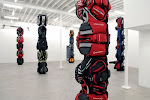However, these attributes about the museum that make it so much more meaningful pale in comparison to the second-rate attempts to attract visitors, specifically the Ramp it Up exhibit. That’s not to say those showings like Ramp it Up cheapen the experience because there are some exhibits with substance like Fritz Scholder’s pop art last semester. I think the curators at this museum are trying to give people what they want—simply art and artifacts with a Native American twist. As I said before, the museum really isn’t about what’s in it, as much as it is what’s it about; the subject. I guess my skin is too pale to realize the vast importance of the artifacts, but it’s hard to capture and relate these seemingly random tools and apparel of these tribes when they haven’t been in existence in over a century. Much of what these tribes stood for—peace, a love of nature, brotherhood, and respect—sadly, gets drowned out by the stereotypical roadside casinos and moccasins.
I can’t help but get caught up in the irony of it all. White people flocking to the NMAI to see what their potential ancestors destroyed, buying “Native American” blankets made in Oregon that was probably once inhabited by Indians in the first place. Native American culture is available and it comes in my size.
D.C. used to look like this outside the Capitol building in the early 1800s when Native Americans were kicked out and then kicked back in to make a museum to make it look similar to the wetlands before.

No comments:
Post a Comment